ChooksChick's
Henthusiasts' Still-Air Styrofoam Incubation Cheat-Sheet
***The first, most important rule is: get the temp right with an empty incubator, and make sure it's stable for 48 hours- without the plugs, without you touching it- BEFORE you add eggs.***
This is the hardest part, and if you can be good and do it, you have a much better shot at success. Do it before you order eggs, even. That gives you time to get it perfect.
Use 3 (yes, 3!) of the sealed-in-glass aquarium thermometers from Wally World ($1.70 each, I always have at least a dozen on hand for my 6 incubators).

Place them where it will be easy to read from the windows, and turn them in the suction cup so they're angled correctly to read the red line through your windows. They need to be on the turner, wedged between eggs so you can read what the center of the egg is, internally.
This is the only reliable way, as the thermometers that come with the incubators on cardboard change as humidity changes, and they tell you the eggs' top temperature or the temp on the floor! Took forever to figure out my incubator wasn't really spiking as badly as the thermometer said, but that the temp spikes were due to the cardboard shrinking and swelling from humidity!
***Recently it has come to my attention that some folks are having issues with these thermometers losing accuracy. I have not experienced this, but thought I ought to post a valuable bit of info to ascertain whether you have accuracy or not in YOUR thermometers.
BYC user Jessshan8 posted this regarding evaluating your thermometer:
Even a tiny bit of difference in height can mean a big difference in yolk-temp so you might wipe them out in the last 3 days if you don't use a carton or prop up the wire. You can mark the turner edge on the styrofoam and use that line to help you position the wire on shallow bowls or compote cups to get the middle of the eggs at the same height they were for the first 18 days. Put the wire back in and you're good to go. Egg cartons are easier. This doesn't affect hatchability, but you won't want the paper towel on the wire AND cardboard cartons, as this will be too humid. Do use the paper towels if you use styrofoam egg cartons. I have also used saucers upside-down and put the wire on those with little silverware baskets from the dollar store to hatch the at the right level. This also keeps them sorted by breed when I have multiple similar-looking breeds hatching.
If you have had both plugs out the whole time, you might be able to get the right temp for them lying on the floor by just plugging both holes, but that's an unknown factor until you've tried it, and you don't want to find out with eggs that are about to hatch. I use a separate machine as the hatcher to avoid this conundrum when I can.
Hope it makes sense! Let me know if you have any questions. ChooksChick at gmail dot com.
I'm adding this Q & A section for frequently asked questions. Let me know if there's something you'd like to see here.
Q. Can you describe your feelings on the humidity portion and why you suggest no water at all?
A. The method I describe is also referred to as 'dry incubation' and it's the only sure way I know of to decrease the embryonic mass by enough in the first 2 1/2 weeks to make the baby small enough to negotiate getting in the right position to pip properly. Many times if there isn't enough evaporation, the chick can't get into the right position to get enough leverage to pip and they never make it out. The chick is just too big.
If there's substantial evaporation, this seems to be less of a problem. You do need to have adequate humidity for the chick to not get glued in, however, so you increase the humidity to prevent the remaining moisture from dying as the chick opens the shell with first the pip and then the zip. That's why it's important to watch the humidity at the end. There's a whole host of various opinions about how to incubate, but this has worked for me a zillion times and I encourage folks to at least read it, even if they choose another method, just to get some ideas about what they observe and have a bit of background so they can make educated decisions as they go through their chosen method the first time.
Q. Will this work on a forced-air incubator?
A. Yes, many have used it on a forced air incubator, but I suggest you don't let the humidity dip below 20% for a prolonged duration, adding a tad of water through a straw if it's that low for more than 24 hours. I also advocate using the paper towels on the last three days STRONGLY, because anytime a pip is large but the pipper is slow, gluing can occur more easily with the fan and air movement.
If you can turn off the fan for the lockdown period, that would be ideal.
Comparison of the air cell at days 7, 14 and 18 will better allow you to predict whether you need to add water in your forced-air incubator or not.
Happy hatching!!


